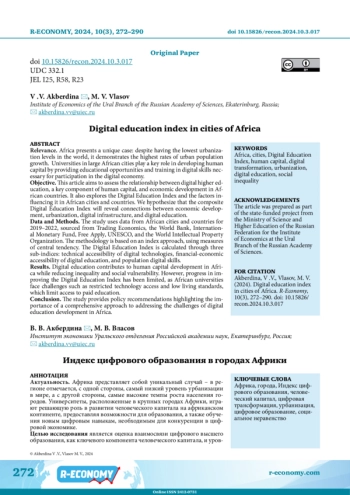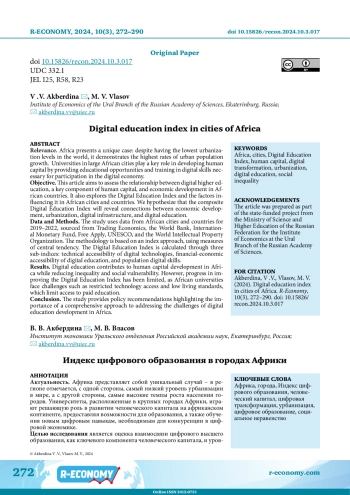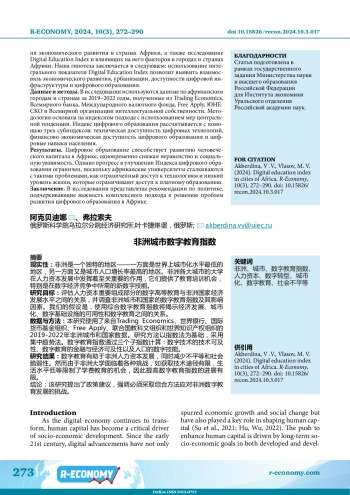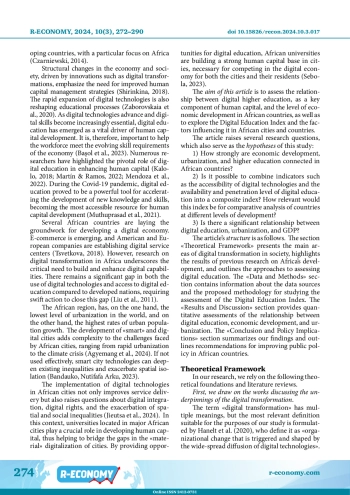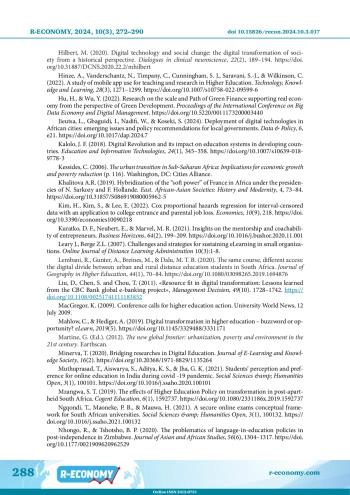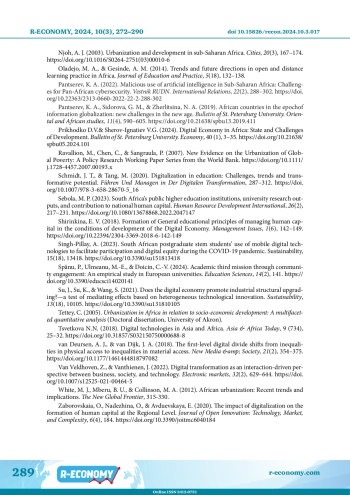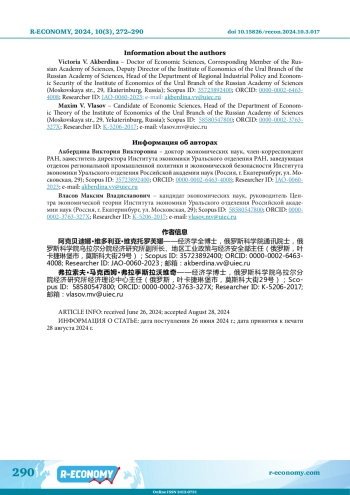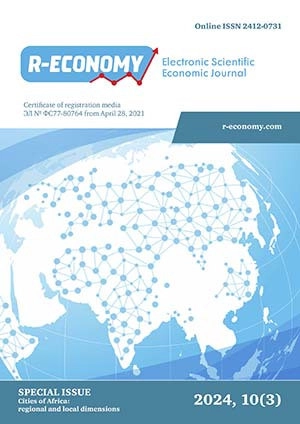Relevance. Africa presents a unique case: despite having the lowest urbanization levels in the world, it demonstrates the highest rates of urban population growth. Universities in large African cities play a key role in developing human capital by providing educational opportunities and training in digital skills necessary for participation in the digital economy. Objective. This article aims to assess the relationship between digital higher education, a key component of human capital, and economic development in African countries. It also explores the Digital Education Index and the factors influencing it in African cities and countries. We hypothesize that the composite Digital Education Index will reveal connections between economic development, urbanization, digital infrastructure, and digital education. Data and Methods. The study uses data from African cities and countries for 2019-2022, sourced from Trading Economics, the World Bank, International Monetary Fund, Free Apply, UNESCO, and the World Intellectual Property Organization. The methodology is based on an index approach, using measures of central tendency. The Digital Education Index is calculated through three sub-indices: technical accessibility of digital technologies, financial-economic accessibility of digital education, and population digital skills. Results. Digital education contributes to human capital development in Africa while reducing inequality and social vulnerability. However, progress in improving the Digital Education Index has been limited, as African universities face challenges such as restricted technology access and low living standards, which limit access to paid education. Conclusion. The study provides policy recommendations highlighting the importance of a comprehensive approach to addressing the challenges of digital education development in Africa.
Идентификаторы и классификаторы
As the digital economy continues to transform, human capital has become a critical driver of socio-economic development. Since the early 21st century, digital advancements have not only spurred economic growth and social change but have also played a key role in shaping human capital (Su et al., 2021; Hu, Wu, 2022). The push to enhance human capital is driven by long-term socio-economic goals in both developed and developing countries, with a particular focus on Africa (Czarniewski, 2014).
Список литературы
1. Agyemang E., Anderson B., Patiño J., Tremolieres M. (2024). Toward achieving smart cities in Africa: challenges to data use and the way forward. Data & Policy, 6, e13. DOI: 10.1017/dap.2024.11 EDN: FEWLEH
2. Akberdina V., Lavrikova Y., Vlasov M. (2024). Environmental financing: does digital economy matter? Frontiers in Environmental Science, 11, 1268286. DOI: 10.3389/fenvs.2023.1268286 EDN: NTAXVS
3. Akberdina V., Naumov I., Krasnykh S. (2022). Regional Digital Space and Digitalisation of Industry: Spatial Econometric Analysis. In International scientific conference on Digital Transformation in Industry: Trends, Management, Strategies (pp. 7-19). Cham: Springer Nature Switzerland. DOI: 10.1007/978-3-031-30351-7_2
4. Alenezi M. (2023). Digital Learning and Digital Institution in higher education. Education Sciences, 13(1), 88. DOI: 10.3390/educsci13010088 EDN: BCETKQ
5. Badmus O., Omosewo E. O. (2020). Evolution of STEM, STEAM and STREAM education in Africa: The implication of the knowledge gap. International Journal on Research in STEM Education, 2(2), 99-106. DOI: 10.31098/ijrse.v2i2.227 EDN: FVKBFJ
6. Bandauko E., Nutifafa Arku R. (2023). A critical analysis of ‘smart cities’ as an urban development strategy in Africa. International Planning Studies, 28(1), 69-86. DOI: 10.1080/13563475.2022.2137112 EDN: EZLGZW
7. Başol O., Sevgi H., Yalçın E. C. (2023). The effect of digitalization on youth unemployment for EU countries: Treat or threat? Sustainability, 15(14), 11080. DOI: 10.3390/su151411080 EDN: DWWLOK
8. Bloom D. E., Khanna T. (2007). The urban revolution. Finance and development, 44(3), 9-14.
9. Bunting I. (2006). The Higher Education Landscape Under Apartheid. In: Cloete, N., Maassen, P., Fehnel, R., Moja, T., Gibbon, T., Perold, H. (eds) Transformation in Higher Education. Higher Education Dynamics, vol 10. Springer, Dordrecht. DOI: 10.1007/1-4020-4006-7_3
10. Cloete N., Bunting I., Maassen P. (2015). Research universities in Africa: An empirical overview of eight flagship universities. Knowledge production and contradictory functions in African higher education, 1, 18-31.
11. Cloete N., Bunting I., Van Schalkwyk F. (2018). Research universities in Africa (p. 314). African Minds. DOI: 10.5281/zenodo.1479114
12. Czarniewski S. (2014). Quality parameters of human capital in the Digital Economy. International Journal of Academic Research in Accounting, Finance and Management Sciences, 4(3). DOI: 10.6007/ijarafms/v4-i3/1182
13. De la Calle A. M., Pacheco-Costa A., Gómez-Ruiz M. Á., Guzmán-Simón F. (2021). Understanding teacher digital competence in the framework of Social Sustainability: A systematic review. Sustainability, 13(23), 13283. DOI: 10.3390/su132313283 EDN: BTYGMB
14. Degani G., Levanon D., Yom Din G. (2021). Academic Research, Higher Education, and peripheral development: The case of Israel. Economies, 9(3), 121. DOI: 10.3390/economies9030121 EDN: BJYGQK
15. Delgado Martín A. V., Larrú Ramos J. M. (2022). DEIFDC framework: Evaluation of Digital Education Deployment in India in the midst of the COVID-19 pandemic. Social Sciences & Humanities Open, 6(1), 100281. DOI: 10.1016/j.ssaho.2022.100281 EDN: LXZYWM
16. Demintseva E.B. (2011). Education in Africa: Challenges, Development, Prospects. Asia and Africa Today, 4(645), 15-17. EDN: OFZPVJ
17. Etzkowitz H., Leydesdorff L. (2000). The Dynamics of Innovation: From National Systems and “mode 2” to a triple helix of University-Industry-government relations. Research Policy, 29(2), 109-123. DOI: 10.1016/s0048-7333(99)00055-4 EDN: DYUGNV
18. Frolova E. V., Rogach O. V., Ryabova T. M. (2020). Digitalization of education in modern scientific discourse: New trends and risks analysis. (2020). European Journal of Contemporary Education, 9(2). DOI: 10.13187/ejced.2020.2.313
19. Gallifa J., Montané M., Lund S., Amorós C., Bernaus M., Gisbert M., Martínez-Olmo F. (2021). Knowledge Building International Project as an innovative learning environment. Canadian Journal of Learning and Technology, 47(2). DOI: 10.21432/cjlt27920 EDN: HNWYEK
20. Hanelt A., Bohnsack R., Marz D., Antunes Marante C. (2020). A systematic review of the literature on Digital Transformation: Insights and implications for strategy and organizational change. Journal of Management Studies, 58(5), 1159-1197. DOI: 10.1111/joms.12639 EDN: XWOGSK
21. Heeks R. (2022). Digital inequality beyond the digital divide: conceptualizing adverse digital incorporation in the global South. Information Technology for Development, 28(4), 688-704. DOI: 10.1080/02681102.2022.2068492 EDN: NQJXXX
22. Hilbert M. (2020). Digital technology and social change: the digital transformation of society from a historical perspective. Dialogues in clinical neuroscience, 22(2), 189-194. DOI: 10.31887/DCNS.2020.22.2/mhilbert EDN: QUHWKK
23. Hinze A., Vanderschantz N., Timpany C., Cunningham S. J., Saravani S.-J., Wilkinson C. (2022). A study of mobile app use for teaching and research in Higher Education. Technology, Knowledge and Learning, 28(3), 1271-1299. DOI: 10.1007/s10758-022-09599-6 EDN: OJWLNP
24. Hu H., Wu Y. (2022). Research on the scale and Path of Green Finance supporting real economy from the perspective of Green Development. Proceedings of the International Conference on Big Data Economy and Digital Management. DOI: 10.5220/0011173200003440
25. Jieutsa L., Gbaguidi I., Nadifi W., Koseki S. (2024). Deployment of digital technologies in African cities: emerging issues and policy recommendations for local governments. Data & Policy, 6, e21. DOI: 10.1017/dap.2024.7 EDN: YXXXDZ
26. Kalolo J. F. (2018). Digital Revolution and its impact on education systems in developing countries. Education and Information Technologies, 24(1), 345-358. DOI: 10.1007/s10639-018-9778-3
27. Kessides C. (2006). The urban transition in Sub-Saharan Africa: Implications for economic growth and poverty reduction (p. 116). Washington, DC: Cities Alliance.
28. Khalitova A.R. (2019). Hybridization of the “soft power” of France in Africa under the presidencies of N. Sarkozy and F. Hollande. East. African-Asian Societies: History and Modernity, 4, 73-84. DOI: 10.31857/S086919080005962-5
29. Kim,H., Kim S., Lee E. (2022). Cox proportional hazards regression for interval-censored data with an application to college entrance and parental job loss. Economies, 10(9), 218. DOI: 10.3390/economies10090218 EDN: UEBOUS
30. Kuratko D. F., Neubert E., Marvel M. R. (2021). Insights on the mentorship and coachability of entrepreneurs. Business Horizons, 64(2), 199-209. DOI: 10.1016/j.bushor.2020.11.001 EDN: RZMQLC
31. Leary J., Berge Z.L. (2007). Challenges and strategies for sustaining eLearning in small organizations. Online Journal of Distance Learning Administration 10(3):1-8.
32. Lembani R., Gunter A., Breines M., Dalu M. T. B. (2020). The same course, different access: the digital divide between urban and rural distance education students in South Africa. Journal of Geography in Higher Education, 44(1), 70-84. DOI: 10.1080/03098265.2019.1694876
33. Liu D., Chen S. Chou T. (2011). “Resource fit in digital transformation: Lessons learned from the CBC Bank global e-banking project”, Management Decision, 49(10). 1728-1742. DOI: 10.1108/00251741111183852
34. MacGregor K. (2009). Conference calls for higher education action. University World News, 12 July 2009.
35. Mahlow C., Hediger A. (2019). Digital transformation in higher education - buzzword or opportunity? eLearn, 2019(5). DOI: 10.1145/3329488/3331171
36. Martine G. (Ed.). (2012). The new global frontier: urbanization, poverty and environment in the 21st century. Earthscan.
37. Minerva T. (2020). Bridging researches in Digital Education. Journal of E-Learning and Knowledge Society, 16(2). DOI: 10.20368/1971-8829/1135264
38. Muthuprasad T., Aiswarya S., Aditya K. S., Jha G. K. (2021). Students’ perception and preference for online education in India during covid -19 pandemic. Social Sciences & Humanities Open, 3(1), 100101. DOI: 10.1016/j.ssaho.2020.100101 EDN: KNOAKU
39. Mzangwa S. T. (2019). The effects of Higher Education Policy on transformation in post-apartheid South Africa. Cogent Education, 6(1), 1592737. DOI: 10.1080/2331186x.2019.1592737
40. Ngqondi T., Maoneke P. B., Mauwa H. (2021). A secure online exams conceptual framework for South African universities. Social Sciences & Humanities Open, 3(1), 100132. DOI: 10.1016/j.ssaho.2021.100132 EDN: YKCVIE
41. Nhongo R., Tshotsho B. P. (2020). The problematics of language-in-education policies in post-independence in Zimbabwe. Journal of Asian and African Studies, 56(6), 1304-1317. DOI: 10.1177/0021909620962529 EDN: ZBGZMW
42. Njoh A. J. (2003). Urbanization and development in sub-Saharan Africa. Cities, 20(3), 167-174. DOI: 10.1016/S0264-2751(03)00010-6
43. Oladejo M. A., Gesinde A. M. (2014). Trends and future directions in open and distance learning practice in Africa. Journal of Education and Practice, 5(18), 132-138.
44. Pantserev K. A. (2022). Malicious use of artificial intelligence in Sub-Saharan Africa: Challenges for Pan-African cybersecurity. Vestnik RUDN. International Relations, 22(2), 288-302. DOI: 10.22363/2313-0660-2022-22-2-288-302 EDN: RFWMPU
45. Pantserev K. A., Sidorova G. M., Zherlitsina N. A. (2019). African countries in the epochof information globalization: new challenges in the new age. Bulletin of St. Petersburg University. Oriental and African studies, 11(4), 590-605. DOI: 10.21638/spbu13.2019.411 EDN: VUIZYH
46. Prikhodko D. V., Sherov-Ignatiev V. G. (2024). Digital Economy in Africa: State and Challenges of Development. Bulletin of St. Petersburg University. Economy, 40 (1), 3-35. DOI: 10.21638/spbu05.2024.101 EDN: YBWQTY
47. Ravallion M., Chen C., Sangraula P. (2007). New Evidence on the Urbanization of Global Poverty: A Policy Research Working Paper Series from the World Bank. DOI: 10.1111/j.1728-4457.2007.00193.x EDN: QSBSTR
48. Schmidt J. T., Tang M. (2020). Digitalization in education: Challenges, trends and transformative potential. Führen Und Managen in Der Digitalen Transformation, 287-312. DOI: 10.1007/978-3-658-28670-5_16
49. Sebola M. P. (2023). South Africa’s public higher education institutions, university research outputs, and contribution to national human capital. Human Resource Development International, 26(2), 217-231. DOI: 10.1080/13678868.2022.2047147 EDN: WYUSUD
50. Shirinkina E. V. (2018). Formation of General educational principles of managing human capital in the conditions of development of the Digital Economy. Management Issues, 1(6), 142-149. DOI: 10.22394/2304-3369-2018-6-142-149
51. Singh-Pillay A. (2023). South African postgraduate stem students’ use of mobile digital technologies to facilitate participation and digital equity during the COVID-19 pandemic. Sustainability, 15(18), 13418. DOI: 10.3390/su151813418 EDN: CJNVON
52. Spânu P., Ulmeanu M.-E., Doicin C.-V. (2024). Academic third mission through community engagement: An empirical study in European universities. Education Sciences, 14(2), 141. DOI: 10.3390/educsci14020141 EDN: WHCCQK
53. Su J., Su K., Wang S. (2021). Does the digital economy promote industrial structural upgrading?-a test of mediating effects based on heterogeneous technological innovation. Sustainability, 13(18), 10105. DOI: 10.3390/su131810105 EDN: HLRBPB
54. Tettey C. (2005). Urbanization in Africa in relation to socio-economic development: A multifaceted quantitative analysis (Doctoral dissertation, University of Akron).
55. Tsvetkova N. N. (2018). Digital technologies in Asia and Africa. Asia & Africa Today, 9 (734), 25-32. DOI: 10.31857/S032150750000688-8 EDN: YLBFCX
56. van Deursen A. J., van Dijk J. A. (2018). The first-level digital divide shifts from inequalities in physical access to inequalities in material access. New Media & Society, 21(2), 354-375. DOI: 10.1177/1461444818797082
57. Van Veldhoven Z., Vanthienen J. (2022). Digital transformation as an interaction-driven perspective between business, society, and technology. Electronic markets, 32(2), 629-644. DOI: 10.1007/s12525-021-00464-5 EDN: KLTTCY
58. White M. J., Mberu B. U., Collinson M. A. (2012). African urbanization: Recent trends and implications. The New Global Frontier, 315-330.
59. Zaborovskaia O., Nadezhina O., Avduevskaya E. (2020). The impact of digitalization on the formation of human capital at the Regional Level. Journal of Open Innovation: Technology, Market, and Complexity, 6(4), 184. DOI: 10.3390/joitmc6040184 EDN: IJGHSD
Выпуск
Другие статьи выпуска
Relevance. The study of inclusive economic growth remains highly relevant as the concept of growth continues to evolve. Measuring and analysing its determinants offers opportunities to foster inclusive growth at both regional and national levels. Research Objective. This study analyses inclusive economic growth in East Java’s districts and cities from 2018-2022 by comparing two measurement models: the Social Mobility Curve (SMC), which focuses on income distribution and economic growth, and the Poverty Equivalent Growth Rate (PEGR), which incorporates poverty, inequality, and unemployment. Data and Method. Using data from Statistics Indonesia (BPS), the National Labour Force Survey (SAKERNAS), and the National Socioeconomic Survey (SUSENAS) for 2018-2022, this study applies the SMC and PEGR models and conducts panel data regression to analyse inclusive growth and its determinants. Results. The findings reveal that economic growth in East Java lacks inclusivity. Income distribution inequality persists across districts and cities, as shown by the SMC results. The PEGR model also indicates ongoing challenges in reducing poverty and unemployment inclusively. Key factors such as the share of manufacturing in GRDP and employment opportunities significantly impact inclusive growth. Conclusions. Encouraging investment growth can create a favourable business climate across all districts/cities, supporting a more equitable contribution to GRDP. As employment opportunities play a significant role in inclusive growth, boosting employment through investment can improve access to education and healthcare, while addressing unemployment. To combat inequality and poverty, the government must refine its data collection on the poor to better target beneficiaries.
Relevance. External shocks can disrupt stable industrial development and technological modernization, especially in open single-industry regions that are highly vulnerable to global market fluctuations. The dominance of a single sector results in structural inertia, making it difficult for these regions to shift their economic trajectory. This path dependence amplifies the risks posed by economic turbulence, highlighting the need for changes in the economic structure and strategic guidelines for regional industrial policies. Objective. This study aims to describe the current, strategic, and future development paths for single-industry regions amid economic turbulence. It focuses on changes in the industrial profiles of metallurgical regions in Russia, including Lipetsk, Vologda, Murmansk, Sverdlovsk, Chelyabinsk, and Krasnoyarsk. Data and methods. The research uses publicly available statistics from 2008 to 2021, grounded in regional development theory. Methodologically, the study relies on coefficient analysis, positional-dynamic analysis, and assessment of technological connections between sectors. Results. The study has detected significant differences in regional adaptation: Lipetsk and Chelyabinsk are shifting towards low-tech sectors, Sverdlovsk maintains its metallurgical focus, Vologda is balancing metallurgy and a medium-high-tech chemical industry, while Murmansk and Krasnoyarsk are transforming with a focus on low-tech mineral extraction. Promising specializations include machine engineering in Sverdlovsk and Vologda, as well as machine engineering and electrical equipment production in Lipetsk and Chelyabinsk. However, we found discrepancies between the declared strategic goals and actual priorities in Lipetsk and Chelyabinsk. Conclusions. The findings offer valuable insights for policymakers and authorities, helping to update strategies for fostering the growth of promising industrial sectors.
Relevance: The stability of money demand is essential for effective monetary policy, especially in Sub-Saharan African (SSA) countries that face various economic challenges. These challenges include volatile exchange rates, fluctuating foreign interest rates, and high inflation, all of which can disrupt money demand stability. Understanding how these dynamics interact with different income levels-upper middle, lower middle, and low-is crucial for developing effective regional monetary policies and achieving economic stability. Research Objective: This study aims to evaluate the stability of money demand across different income levels-upper middle, lower middle, and low-in SSA. By applying the cash-in-advance theory, the study seeks to provide insights and actionable policy recommendations on the influence of key economic variables. Data and Method. This study employs the cross-sectional augmented autoregressive distributed lag (CS-ARDL) model to analyze both the short- and longrun influences of real exchange rates, foreign interest rates, real GDP, and inflation on money demand. By doing so, it aims to provide a nuanced understanding of money demand stability, capturing variations often overlooked in existing research. The analysis uses data from the World Bank Indicators and the International Monetary Fund (IMF), allowing for a detailed examination of money demand stability across various income levels in the region. Results. The findings reveal a positive and significant relationship between the real exchange rate, foreign interest rates, real gross domestic product, and real monetary aggregates. However, inflation has a contractionary effect on the real monetary aggregate, destabilizing money demand. Money demand stability is observed in upper-middle and low-income countries, while lower-middle-income countries exhibit variability, indicating differing levels of economic resilience across income categories. Conclusion. The study recommends adopting unified monetary policies and a single currency to enhance stability and stimulate economic growth in the region. Additionally, implementing inflation-targeting policies can further strengthen economic stability and promote sustainable development in SSA.
Relevance. Local governments in both developed and developing countries act as a vital link between central governments and local communities. Central government funding transfers to local governments are often based on performance measures. In Ghana, the District Performance Assessment Tool (DPAT) has been utilized to evaluate local government performance since 2018, with a primary focus on improving service delivery to meet the needs of local residents. Research objective. This paper aims to analyze how the DPAT was conducted for the five selected local governments in the Central Region of Ghana from 2021 to 2022. Data and methods. The study employs a qualitative approach to the analysis of the primary data gathered from ten technical officers and 16 Assembly members, who served as key informants. A document review guide was also used to collect secondary data. Results. While the DPAT indicators aimed at assessing service delivery to communities, many were focused primarily on the internal operations of local governments. Although the DPAT represents an improvement over the District Development Facility’s Functional and Organizational Assessment Tool, the assessors did not interview Assembly members to verify the services delivered in the communities. Conclusions. The findings and methods of this study can inform analyses of local government performance in Ghana. It is recommended that DPAT assessors conduct field visits to interview Assembly members to enhance the assessment process. This study contributes to the understanding of financial resource allocation and service delivery in local governments.
Relevance. Libya has been struggling with fresh water shortages for much of its history. This issue started to be resolved only after significant underground water reserves were discovered in the southern part of the country in the late 1960s. From 1970 to 2010, the country became one of the world leaders in terms of water consumption per capita. Research objective. The study aims to evaluate compliance adopted and proposed solutions for developing the water supply system for urban settlements and agricultural enterprises in Libya, implemented during Muammar Gaddafi’s leadership, align with the canonical theories of Spatial Science. Data and method. Methodologically, the study relies on the principles of the isolated state theory and the central place theory. The transformation of the water supply structure in Libya studies within the evolutionary approach on using the example of agricultural projects and settlement projects in the Kufra region, as well as the “Great Man-Made River” project. Results. Each state farm in Libya represents a quasi “isolated state” which is the first stage in the development of the country’s water supply system. However, it only becomes a system in the proper sense at the second stage, with the emergence of private farms in settlements: central place systems with one (rarely two) levels of hierarchy arise “from” the rural areas. The transition to the third stage-the formation of a full-fledged central place system-was made possible by the “Great Man-Made River” project. Conclusions. The water supply systems for the population and economy of Libya in their current form are characterized by fairly high spatial stability. The government’s decision to merge the previously separate water supply systems of Al-Kufra - Sirt / Benghazi and Hasouna - Sahl Jefara through the “Great Man-Made River” project was quite reasonable. Equally prudent was the choice to maintain the Ghadames - Zwara - Zawia system as an isolated entity. However, the project to extend the water pipeline from Ajdabiya to Tobruk, which is currently less than 1% complete, should be discontinued. Instead, it would be more practical to revisit the previously rejected plan to supply freshwater to the cities along Libya’s eastern coast from the local underground sources.
Relevance. Urbanization is a crucial transformative process that plays a key role in achieving sustainable economic development in the global economy. An urbanized economy can serve as a vital structural mechanism to foster inclusive economic growth by generating employment, reducing income inequalities, and alleviating poverty. However, Sub-Saharan Africa (SSA) is characterized by a unique and slow urbanization process that sets it apart from other regions, despite steady economic growth in recent decades. Research Objective. This study aims to empirically assess the patterns and determinants of urbanization in SSA, focusing on the question of whether it is driven primarily by mere economic survival or by improvements in quality of life. Data and Methods. Based on Lee’s rural push-urban pull migration theory, the Common Correlated Effects Mean Group estimator was used to analyze data from 44 SSA countries between 1996 and 2022. Results. Access to basic amenities has a positive and significant impact on urbanization in Africa, although the effect was more modest for improved amenities. Additionally, the agricultural sector was found to hinder urbanization, while the manufacturing and services sectors promote it through structural transformation. Conclusion. The paper concludes that urbanization in SSA is driven by both the need for economic survival and the desire to improve quality of life. To enhance the region’s global competitiveness, it is crucial to invest in and develop critical infrastructure that supports the urbanization process.
In 2007, the world reached a pivotal moment in the ongoing process of urbanization, with the global urban population surpassing the rural population for the first time. Africa is the only continent where this process has not yet been completed. According to UN projections, it is expected to occur no earlier than the second third of the 21st century. Africa, however, is very diverse in this regard: in some countries, the majority of the population has long been urban, while in others, most of the population are still living in rural areas.
Статистика статьи
Статистика просмотров за 2025 год.
Издательство
- Издательство
- УрФУ
- Регион
- Россия, Екатеринбург
- Почтовый адрес
- 620002, Свердловская область, г. Екатеринбург, ул. Мира, д. 19
- Юр. адрес
- 620002, Свердловская область, г. Екатеринбург, ул. Мира, д. 19
- ФИО
- Кокшаров Виктор Анатольевич (Ректор)
- E-mail адрес
- rector@urfu.ru
- Контактный телефон
- +7 (343) 3754507
- Сайт
- https://urfu.ru/ru
